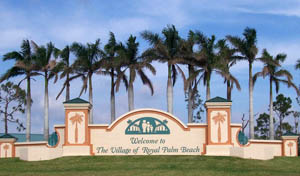After months of strife involving Royal Palm Beach residents’ complaints of weeds choking village canals, representatives of Clarke Aquatics told the Royal Palm Beach Village Council last week that the issue has been largely controlled.
The company reported at the council’s Oct. 3 meeting that it is also doing a complete scan of the canals that will be used for both future weed control but also planned dredging activities.
Clarke has been the village’s aquatic plant contractor for three years and is under scrutiny by council members for what residents say has been unsatisfactory performance.
At a recent meeting, council members demanded full reports every other month on the status of aquatic weed control. Clarke’s contract calls for 90 percent control of all exotic and undesirable nuisance species and 85 percent control of all exotic and undesirable emergent, floating and submerged vegetation.
Royal Palm Beach Utilities Director Paul Webster said the M-1 Canal floodgate operating at maximum capacity can evacuate the water volume in the combined canal systems of Royal Palm Beach and the Indian Trail Improvement District in less than a day.
“It’s an open system and can interact hydrologically and biologically throughout the system,” Webster said. “Biological growth in the system is very fluid and can change significantly in short periods of time.”
Webster said many of the more than two dozen aquatic plants the contractor is charged with controlling are exotics that were most likely introduced into the system by people dumping their aquariums.
The contract’s goal is to maintain the canals for the purposes of flood control, fishing, boating and aesthetic purposes.
“The competing uses of the canals is what determines the balance he is trying to meet in the management of the aquatic vegetation in the system,” Webster said. “For flood control, the system must be clear of enough aquatic vegetation that the flow is not impeded during storm events. For fishing, fishermen like grasses that grow on the sides as a habitat for fish, and leave the center opened up so they can traverse the system to go get the fish.”
Recreational boaters want more of the system opened up, while residents along the canals want all of the canal opened so they can enjoy the view and dock their boats without being surrounded by floating debris, Webster said.
Clarke Water Resources Manager Dr. Brett Bultemeier, who holds a Ph.D. in aquatic plant management from the University of Florida, said each of those groups will be in conflict with each other, although there is general agreement that the undesirable plants should be removed.
“Our job is to find the best balance between those groups where everybody can have a system that they can use for these purposes, but not necessarily one group dominating over the other,” Bultemeier said.
He said his company could remove all the plants in the system, but that the large amounts of nutrients left in the system would then promote algae growth.
Webster said amendments have been made to the contract to address some of the issues that have arisen, including a requirement to inspect the entire system during the last week of the month for floating vegetative debris, and submit a plan by the end of the month to remove the floating vegetation by the middle of the following month.
“That requirement was added to try and keep that aesthetic use of the canal,” Webster said.
Webster added that his department has someone inspecting the waterways weekly to verify the contractor’s report.
Clarke’s Assistant Regional Operations Supervisor Mark Grundy, whose office in Wellington services the Royal Palm Beach contract, said the village’s canals were about 90.8 percent clear and the M-1 Canal was 95 percent clear as of September.
Grundy said some floating debris, primarily tape grass, had been identified in the M-1 Canal floating south as the system drained, and floating hygrophila mats had been seen in the La Mancha area and near Crestwood Middle School. He said the mats tend to move around, but Clarke keeps track of them, and the company deploys a harvester that picks them up.
Control for specific plant growth is underway in the shallow canals near the Royal Palm Beach Recreation Center. They have also initiated a control plan for a newly identified plant of the genus rotala.
“We are developing a plan that specifically attunes to that species, with specific chemicals, specific visits just to treat that species,” Grundy said. “A lot of times what you’ll find with these species is that they react to different chemicals, so you have to make multiple visits to the same sites in order to effectively treat them.”
Grundy pointed out that rain increases the water flow through the canals, which impedes the effectiveness of the chemicals.
From June through September, Clarke worked for 226 hours in addition to treatment crews removing floating vegetation in the village’s waterways and the M-1 Canal that weighed about 6,000 pounds after it had dried.
Grundy said under Bultemeier’s supervision, the company is starting to do soundings and mappings of the waterways. “Previously, everything was done through visual observation,” Grundy said. “We decided to implement another tool.”
Webster said the cost of the sounding maps is within the budget and will give data on the depth of the system, the percentage of biomass by volume, and the consistency of the sediment.
“The biomass volume is beneficial as it provides a definitive percentage of control within the system, and the contractor can optimize that treatment program,” Webster said. “It can also provide us with a baseline for our dredging program in our capital program.”
The need for future dredging was pointed out when the village created its stormwater utility to finance maintenance and improvements to its drainage system.
“We still have to develop a full dredging program, but this gives us a good baseline on where to start that program,” Webster said.








